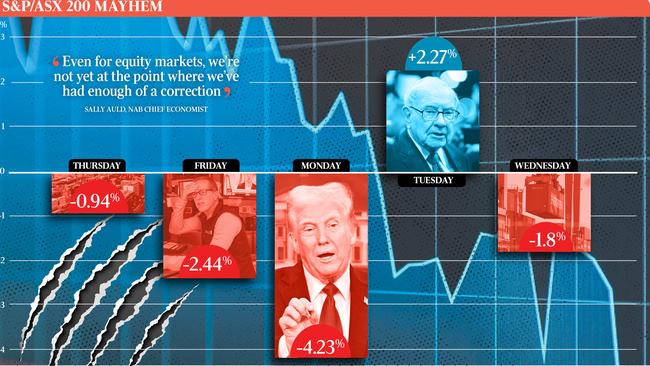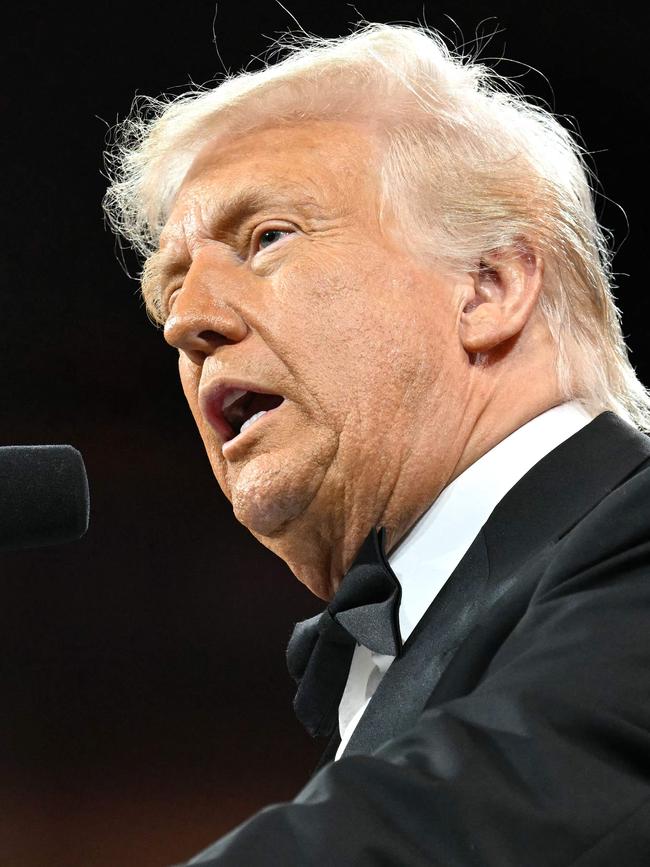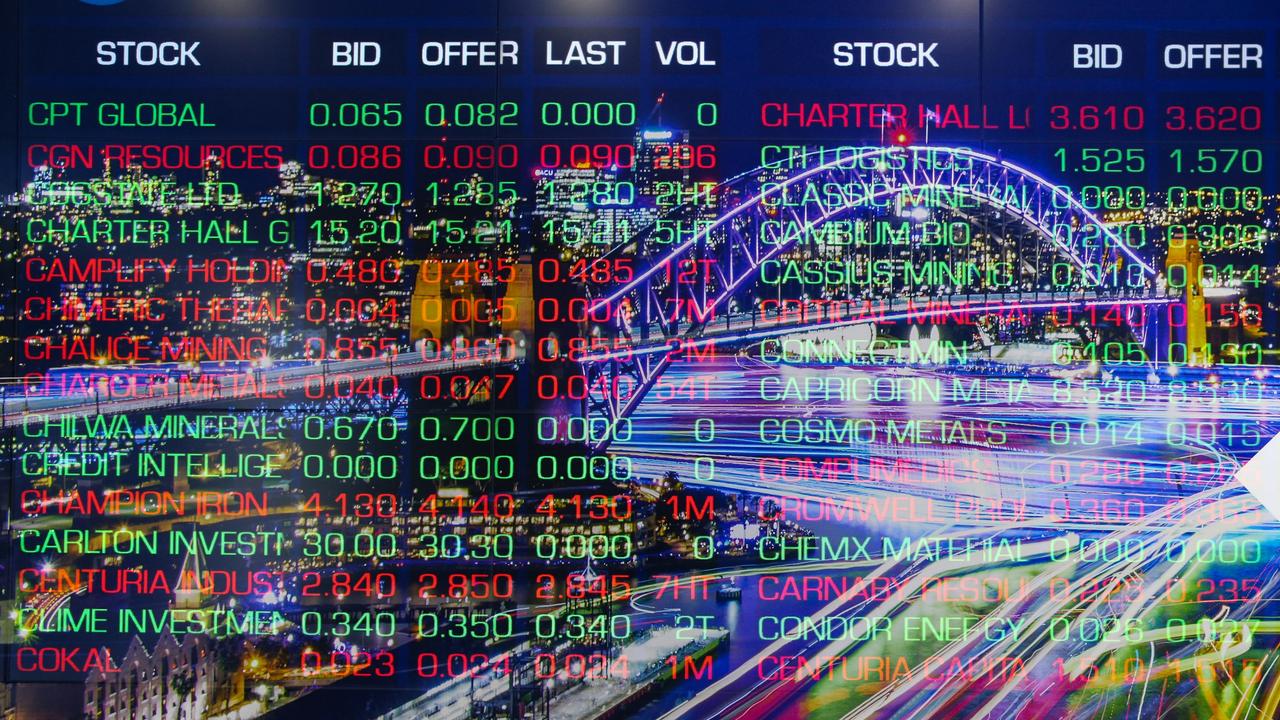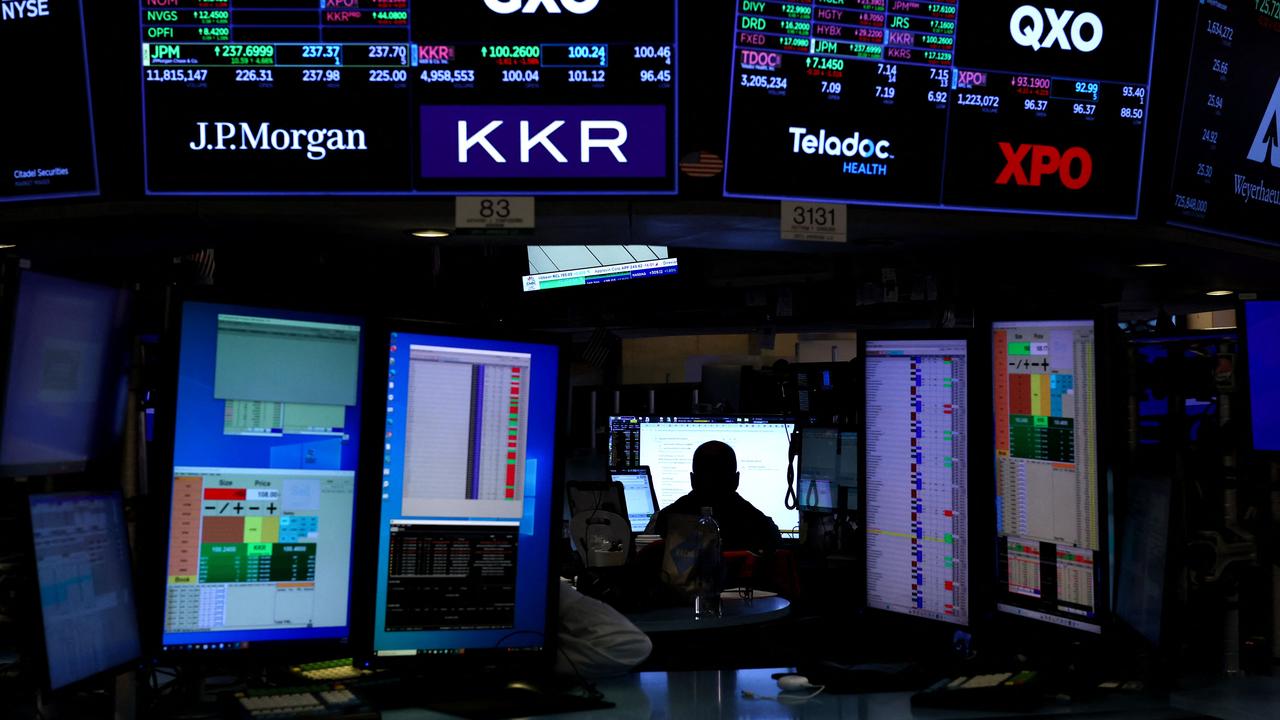
After a volatile session on Wall Street where stock benchmarks erased big intraday gains, the S&P 500 was on the cusp of a bear market, having fallen 18.9 per cent from its record high.
Worse, the renewed fall in stocks occurred alongside selling in US government bonds and the US dollar, leaving investors with few places to hide apart from gold and Japanese yen.
Reflecting an unusual scramble for cash in global markets, and potentially some jitters about large scale US Treasury bond auctions coming up this week, the 30-year US Treasury yield — which drives US mortgage rates — hit a 17-month high of 5.02 per cent. At least it took the focus off the relentless selling in stocks.
In Australia, the 10-year government bond yield soared 15 basis points to 4.39 per cent, even as the S&P/ASX 200 index fell 1.8 per cent to 7375.
NAB chief economist Sally Auld warned stocks hadn’t corrected enough to account for the trade war since valuations were so extreme before the historic drawdown.
The sharemarket sank 4.2 per cent on Monday, its worst one-day sell-off since March 2020.
China’s tariffs take effect on Thursday.
“We don’t know the final outcome where we’re going to settle on all of this (the trade war),” Ms Auld said. “Even for equity markets, we’re not yet at the point where we’ve had enough of a correction, because the starting point was really one of such elevated valuations and pretty optimistic earnings growth even though we’ve had a decent correction in the last week or so.”
Even as the S&P 500 fell 1.6 per cent on Tuesday, the US 10-year bond yield rose 11 basis points to 4.29 per cent, signalling a breakdown in the safe-haven status of US Treasuries.

Even using slightly conservative assumptions for the economic outlook, the pullback in stocks could have further to go as company earnings forecasts are likely to be downgraded.
“I think while that impetus for further correction and further de-rating of the market hangs over investors’ heads, I think it is going to be hard to get a sustainable rally from here,” she said.
Resources stocks were worst off as commodity prices fell. Santos fell 5.7 per cent and BHP lost 3.5 per cent while Mineral Resources dived 12 per cent as Citi downgraded some lithium miners and investors speculated over the risk MinRes raises equity capital, as reported by The Australian’s DataRoom column.

The Australian dollar fell as much as 0.8 per cent to a fresh five-year low of US59.15c, with iron ore prices hitting a seven-month low of $US93.25 per tonne. The Chinese yuan weakened and expectations of Reserve Bank interest rate cuts increased.
New Zealand’s central bank opted for a 25 basis points cut in its official cash rate to 3.5 per cent after its policy meeting on Wednesday. Interest rate swaps priced in 43 basis points of rate cuts by the RBA after its May meeting, up from 30 basis points on Tuesday. About 121 basis points of cuts or almost five standard reductions are expected from the RBA by March 2026.
Rate cut speculation intensified as Treasurer Jim Chalmers called an emergency meeting of the Council of Financial Regulators to discuss the financial market volatility caused by the trade war.
Across the region, Japan’s Nikkei 225 was down about 4 per cent and South Korea’s KOSPI fell 2 per cent, but China’s Shanghai Composite jumped 1.1 per cent after the offshore Chinese yuan depreciated to a record 7.4290 to the US dollar.
Fixed income analysts remained concerned about a potential “regime shift” whereby US Treasuries are no longer a reliable “global fixed income safe haven” in times of stress.
“Despite a significantly higher recession risk for the US economy, the past couple of sessions have seen a disorderly bear steepening in the US Treasury curve, with long-term yields now trading above pre-tariff levels,” said BetaShares head of fixed income Chamath De Silva.
“What is particularly notable is that this has occurred amid a broader risk-off backdrop, with other recession signals such as a weaker USD/JPY and falling crude prices pointing in the opposite direction.” With inflation-adjusted long-term rates rising, “this reinforces the tightening in financial conditions, even as macro fundamentals continue to deteriorate.”
Citi global interest rate strategist Ben Wiltshire said the unusual linkage between US Treasury bonds and stocks was due to a redistribution of global capital flows, concern about the US bond auctions this week with the budget reconciliation front of mind and a renewed focus on funding markets.
He warned a traditional US 60:40 investment portfolio “isn’t working like it theoretically should” as both stocks and bonds are losing money due to the regime shift in US Treasury markets.
While the Trump Administration aims to reduce the US’s current account deficit, lessening a shift in the foundations of global trade could have ramifications for foreign US dollar reserves.
“Funding concerns tend to exponentially increase in relevance for markets,” Mr Wiltshire added.
“Currently funding markets remain contained but there are a lot of bonds and a lot of leverage which means there is an elevated sensitivity to any funding shifts or concerns of a shift.”
Bell Potter head of institutional sales and trading Richard Coppleson noted talk of global reserve managers potentially re-evaluating their positions in US government debt given the seismic impact of Trump’s trade policies.
Meanwhile, a sell-off in US junk bonds saw their spread to US Treasuries widen by the most since the Covid shock and ranks among the biggest increases since 1997.






Enforcement of the United States’ aggressive tariff regime was met with another wild ride for stocks, with $47bn wiped off the ASX as US tariffs including a 104 per cent impost on Chinese goods took effect amid market carnage.